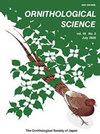Acoustic Parameters Related to Behavioral Discrimination of Emotional Vocalizations in Java Sparrows
IF 0.3
4区 生物学
Q4 ORNITHOLOGY
引用次数: 0
Abstract
Abstract Animals emit vocalizations related to internal or external states, such as hormone levels or predation risks. The Java Sparrow Lonchura oryzivora, a songbird, produces similar trill-structured calls in both aggressive and affiliative situations. A previous study found that trills produced in aggressive situations (AG trills) are faster, louder, and have a wider range of frequencies than trills produced in affiliative situations (AF trills). To assess whether Java Sparrows perceive these trills as different calls, we conducted a playback experiment using a habituation-dishabituation paradigm. In this paradigm, we first played a stimulus set for ten minutes (habituation stimulus), and after that we played either a test stimulus set or a control stimulus set. We analyzed behavioral changes in the study bird that took place between the last minute of the habituation stimulus and the next stimulus set (test or control). As trill stimuli, we used natural AG and AF trills (Experiment 1) and trills in which the trill rates and syllables types were modified (Experiment 2). The results showed that Java Sparrows distinguish between AG and AF trills (Experiment 1). However, when the trill acoustic structure was modified, they distinguished between the different syllable types, but not between different trill rates. As we used a natural behavior as an index, we could not measure the perceptual limit of trill discrimination in these birds. Instead, here, we asked whether the difference between AG and AF trills is meaningful or not, and which acoustic features were important for discrimination. To fully understand how birds perceive vocalizations in the context of communication, more experiments are required, both controlled experiments utilizing operant conditioning and electrophysiology, and multimodal experiments that reflect natural social relationships.Java Sparrows中与情感发声行为辨别相关的声学参数
动物发出的声音与内部或外部状态有关,如激素水平或捕食风险。爪哇麻雀(Lonchura oryzivora)是一种鸣禽,在攻击和亲近的情况下都会发出类似的颤音结构的叫声。先前的一项研究发现,在攻击性情况下产生的颤音(AG颤音)比在从属情况下产生的颤音(AF颤音)更快、更响、频率范围更广。为了评估Java麻雀是否将这些颤音视为不同的呼叫,我们使用习惯-不习惯范式进行了回放实验。在这个范例中,我们首先玩一个刺激组10分钟(习惯刺激),然后我们玩一个测试刺激组或一个控制刺激组。我们分析了研究鸟在习惯化刺激的最后一分钟和下一组刺激(测试或控制)之间发生的行为变化。作为颤音刺激,我们使用自然的AG颤音和AF颤音(实验1)以及颤音频率和音节类型被改变的颤音(实验2)。结果表明,Java麻雀能够区分AG颤音和AF颤音(实验1)。然而,当颤音的声学结构被改变时,它们只能区分不同的音节类型,而不能区分不同的颤音频率。由于我们使用自然行为作为指标,我们无法测量这些鸟类颤音辨别的感知极限。相反,在这里,我们问的是AG和AF颤音之间的差异是否有意义,以及哪些声学特征对区分很重要。为了充分了解鸟类在交流背景下如何感知发声,还需要更多的实验,包括利用操作性条件反射和电生理学的对照实验,以及反映自然社会关系的多模态实验。
本文章由计算机程序翻译,如有差异,请以英文原文为准。
求助全文
约1分钟内获得全文
求助全文
来源期刊

Ornithological Science
ORNITHOLOGY-
CiteScore
1.20
自引率
0.00%
发文量
26
审稿时长
>12 weeks
期刊介绍:
Ornithological Science publishes reviews, original articles, short communications and comments covering all aspects of ornithology. Manuscripts are judged on the basis of their contribution of original data and ideas or interpretation. All articles are peer-reviewed by at least two researchers expert in the field of the submitted paper. Manuscript are edited where necessary for clarify and economy. Ornithological Science aims to publish as rapidly as is consistent with the requirements of peer-review and normal publishing constraints.
 求助内容:
求助内容: 应助结果提醒方式:
应助结果提醒方式:


